Division of a polynomial by another polynomial is one of the important concept in Polynomial expressions. In this article explained about basic phenomena of diving polynomial algorithm in step by step process
Algebra division| Dividing Polynomials Long Division
Before going to algebra divisions observe the normal numerical division algorithm
When we divide 137 by 5 we get the quotient 27 and remainder 2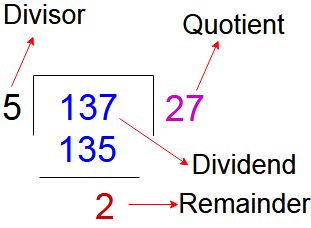
We can write 137 as
137 = (5 x 27) + 2 (Note : Here remainder 2 and it is less than divisor 5)
i.e Dividend = Divisor x Quotient + Remainder
The same division algorithm of number is also applicable for division algorithm of polynomials.
i.e When a polynomial divided by another polynomial
Dividend = Divisor x Quotient + Remainder, when remainder is zero or polynomial of degree less than that of divisor
A polynomial f(x) is divided by another polynomial g(x) we get quotient q(x) and remainder p(x) such that
f(x) = g(x) . q(x) + p(x)
Where p(x) = 0 or degree of p(x) < degree of g(x)
Polynomial long division examples with solution
Dividing polynomials by monomials
Take one example
Example -1 : Divide the polynomial 2x4 +3x2 +x by x
Here
= 2x3 + 3x +1
So we write the polynomial 2x4 +3x2 +x as product of x and 2x3 + 3x +1
2x4 +3x2 +x = (2x3 + 3x +1) x
It means x & 2x3 + 3x +1 are factors of 2x4 +3x2 +x
Example – 2 : Divide the polynomial 3x3 + 9x2 + 5 by 3x
Here variable “x” in denominator so it is not a polynomial.
So polynomial of 3x3 + 9x2 + 5 can be written as
3x3 + 9x2 + 5 = 3x (x2 + 3x) +5
Here we can say (x2 + 3x) is the quotient, 3x is the divisor and 5 is the remainder. And also we can say that the reminder is not zero, 3x is not a factor of 3x3 + 9x2 + 5
Dividing Polynomials by Binomials
Example – 3: Divide the polynomial 4x2-3x +x3 +10 by x+4 and verify the remainder with zero of the divisor
Solution: Say f(x) = 4x2-3x +x3 +10 and g(x)= x+4
For this division, we have using the steps as follows
Step: 1 – Arrange the terms of the dividend f(x) and the divisor g(x) in descending order of their degree
f(x)= x3 +4x2-3x +10 and g(x) = x+4
Step:2 – We get first term of quotient by dividing the first term of dividend (i.e x3 ) with first term of divisor (i.e x)
So
Step:3 – Now the first term of quotient x2 multiplying the divisor g(x) and that term subtract from dividend
x2 (x +4) = x3 +4x2
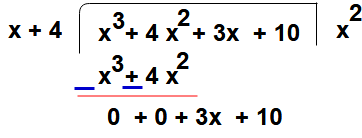
Step : 4 – Now repeat the step 2 again
i.e To get second term of quotient by dividing the first term of get remainder in previous step (i.e 3x ) with first term of divisor (i.e x)
So
Step:5 – Then second term of quotient 3 multiplying the divisor g(x) and that term subtract from remainder got in step 3
3(x +4) = 3x + 12
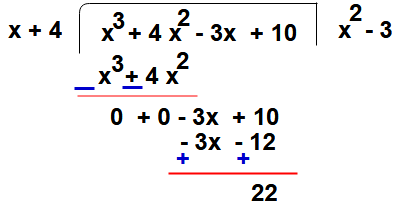
Here the quotient is (x2 – 3) and remainder is 22
Here we can write this division process as
Dividend = Divisor x Quotient + Remainder
f(x) = (x2 – 3) g(x) + 22
x3 +4x2-3x +10 = (x2 – 3) ( x+4) + 22
By using the remainder theorem we obtaining the remainder without performing the above process
Note : Remainder theorem applicable only for divisor have linear polynomial with one variable
Consider zero of the polynomial of g(x) is – 4
g(x) = x +4
g(-4) = -4 +4 = 0
Now find the value of f(x) at x= -4
f(4) = 4 (-4)2 – 3(-4) + (-4)3 + 10 = 22
Dividing Polynomials by Trinomials
Example -4: Divide the polynomial 5x5 + x2 + 3x3 – 4x4– 10 by 2 + x2 – x
Solution: Say f(x) = 5x5 + x2 + 3x3 – 4x4– 10 and g(x)= 2 + x2 – x
Now divide f(x) by g(x) by the following steps
Step: 1 – Arrange the terms of the dividend f(x) and the divisor g(x) in descending order of their degree
f(x)= 5x5 – 4x4 + 3x3 + x2 – 10 and g(x) = x2 – x + 2
Step:2 – We get first term of quotient by dividing the first term of dividend (i.e 5x5 ) with first term of divisor (i.e x2)
So
Step : 3 – Now the first term of quotient 5x3 multiplying the divisor g(x) and that term subtract from dividend
5x3 (x2 – x + 2) = 5x3 – 5x4 + 10x3
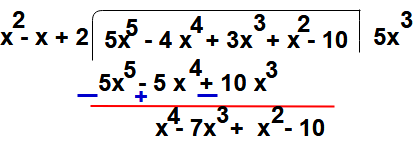
Step : 4 – Now repeat the step 2 again
i.e To get second term of quotient by dividing the first term of get remainder in previous step (i.e x4 ) with first term of divisor (i.e x2)
So
Step:5 – Then second term of quotient x2 multiplying the divisor g(x) and that term subtract from remainder got in step 3
x2 (x2 – x + 2) = x4 – x3 + 2x2
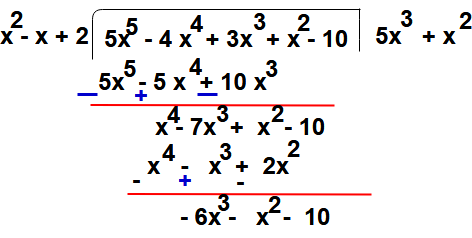
Step : 6 – Now repeat the step 4 again
i.e To get third term of quotient by dividing the first term of get remainder in previous step (i.e -6x3 ) with first term of divisor (i.e x2)
So
Step:7 – Then third term of quotient -6x multiplying the divisor g(x) and that term subtract from remainder got in step 5
-6x (x2 – x + 2) = -6x3 + 6x2 – 12x
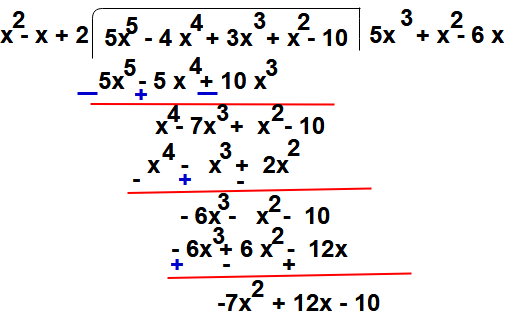
Step : 8 – Now repeat the step 6 again
i.e To get forth term of quotient by dividing the first term of get remainder in previous step (i.e -7x2 ) with first term of divisor (i.e x2)
So
Step:9 – Then forth term of quotient -7 multiplying the divisor g(x) and that term subtract from remainder got in step 7
-7 (x2 – x + 2) = -7x2 + 7x – 14
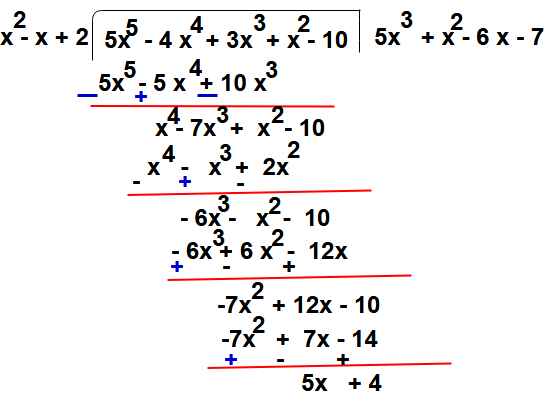
Here the division process is completed because degree of (5x + 4) = 1 which is less than the degree of the divisor (x2 – x + 2)
So the quotient is (5x3 + x3 -6x – 7) and remainder is 5x + 4
Here we can write this division process as
Dividend = Divisor x Quotient + Remainder
f(x) = (5x3 + x3 -6x – 7) g(x) + ( 5x + 4)
(5x5 + x2 + 3x3 – 4x4– 10) = (5x3 + x3 -6x – 7) (x2 – x + 2) + ( 5x + 4)
Dividing Polynomials by Quadratics
Example: Divide the polynomial 1 + x + 5x5 -4x4 + 3x3 – 2x2 by 2 + x + x2 + x3
Solution: Say f(x) = 1 + x + 5x5 -4x4 + 3x3 – 2x2 and g(x)= 2 + x + x2 + x3
Now divide f(x) by g(x) by the following steps
Step: 1 – Arrange the terms of the dividend f(x) and the divisor g(x) in descending order of their degree
f(x)= 5x5 -4x4 + 3x3 – 2x2 + x +1 and g(x) = x3 + x2 + x + 2
Step:2 – We get first term of quotient by dividing the first term of dividend (i.e 5x5 ) with first term of divisor (i.e x3)
So
Step:3 – Now the first term of quotient 5x2 multiplying the divisor g(x) and that term subtract from dividend
5x2 (x3 + x2 + x + 2) = 5x5 + 5x4 + 5x3 + 10x2

Step : 4 – Now repeat the step 2 again
i.e To get second term of quotient by dividing the first term of get remainder in previous step (i.e -9x4 ) with first term of divisor (i.e x3)
So
Step:5 – Then second term of quotient -9x multiplying the divisor g(x) and that term subtract from remainder got in step 3
-9x (x3 + x2 + x + 2) = -9x4 – 9x3 – 9x2 – 18x
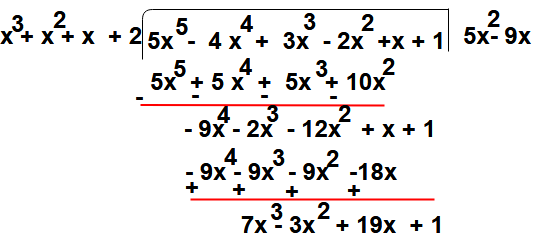
Step : 6 – Now repeat the step 4 again
i.e To get third term of quotient by dividing the first term of get remainder in previous step (i.e 7x3 ) with first term of divisor (i.e x3)
So
Step:7 – Then third term of quotient 7 multiplying the divisor g(x) and that term subtract from remainder got in step 5
7 (x3 + x2 + x + 2) = 7x3 + 7 x2 + 7x + 14
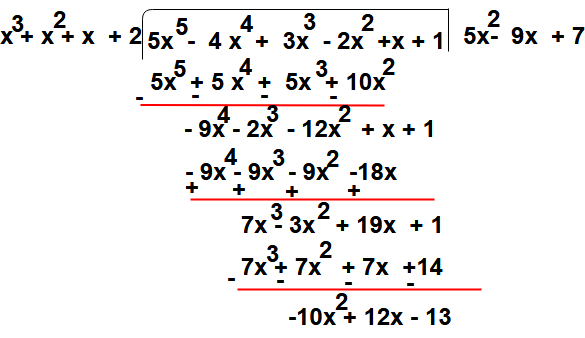
Here the division process is completed because degree of (- 10x2 + 12x -13 ) = 2 which is less than the degree of the divisor (x3 + x2 + x + 2)
So the quotient is (5x2 -9x + 7) and remainder is -10x2 + 12x -13
Here we can write this division process as
Dividend = Divisor x Quotient + Remainder
f(x) = (5x2 -9x + 7) g(x) + ( -10x2 + 12x -13 )
(5x5 -4x4 + 3x3 – 2x2 + x +1) = (5x2 -9x + 7) (x3 + x2 + x + 2) + ( -10x2 + 12x -13 )
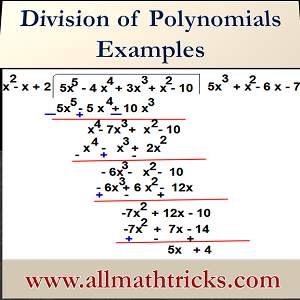
I Hope you liked this article about division of polynomials examples with solutions. Give feed back, comments and please don’t forget to share it.
Related Topics
Polynomial Basic Concepts | Types of polynomials | Algebraic Expressions
Remainder and Factor Theorem Proof | Remainder and Factor Theorem Test
Remainder Theorem Tough Questions for Competitive Exams | Aptitude Questions





